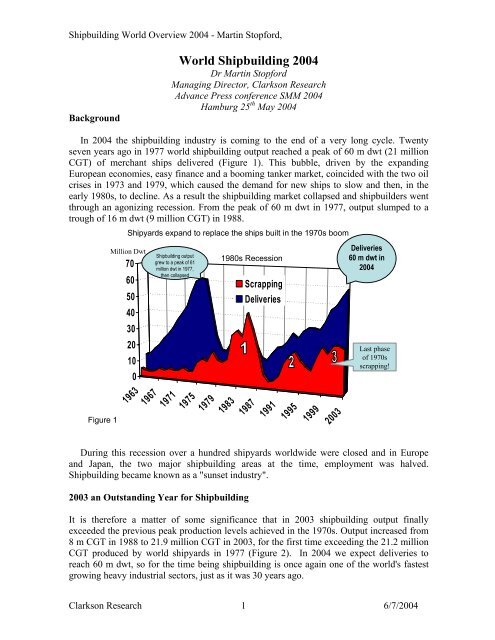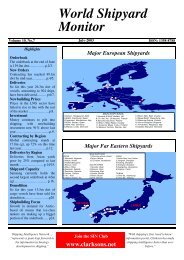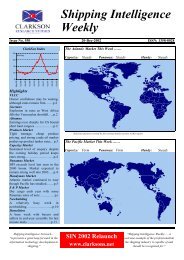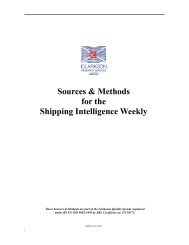Shipbuilding World Overview 2004
Shipbuilding World Overview 2004
Shipbuilding World Overview 2004
You also want an ePaper? Increase the reach of your titles
YUMPU automatically turns print PDFs into web optimized ePapers that Google loves.
<strong>Shipbuilding</strong> <strong>World</strong> <strong>Overview</strong> <strong>2004</strong> - Martin Stopford,<br />
Background<br />
<strong>World</strong> <strong>Shipbuilding</strong> <strong>2004</strong><br />
Dr Martin Stopford<br />
Managing Director, Clarkson Research<br />
Advance Press conference SMM <strong>2004</strong><br />
Hamburg 25 th May <strong>2004</strong><br />
In <strong>2004</strong> the shipbuilding industry is coming to the end of a very long cycle. Twenty<br />
seven years ago in 1977 world shipbuilding output reached a peak of 60 m dwt (21 million<br />
CGT) of merchant ships delivered (Figure 1). This bubble, driven by the expanding<br />
European economies, easy finance and a booming tanker market, coincided with the two oil<br />
crises in 1973 and 1979, which caused the demand for new ships to slow and then, in the<br />
early 1980s, to decline. As a result the shipbuilding market collapsed and shipbuilders went<br />
through an agonizing recession. From the peak of 60 m dwt in 1977, output slumped to a<br />
trough of 16 m dwt (9 million CGT) in 1988.<br />
Figure 1<br />
Shipyards expand to replace the ships built in the 1970s boom<br />
Million Dwt<br />
70<br />
60<br />
50<br />
40<br />
30<br />
20<br />
10<br />
0<br />
1963<br />
1967<br />
<strong>Shipbuilding</strong> output<br />
grew to a peak of 61<br />
million dwt in 1977,<br />
then collapsed<br />
1971<br />
1975<br />
1979<br />
1980s Recession<br />
1983<br />
1987<br />
1991<br />
1995<br />
Scrapping<br />
Deliveries<br />
1999<br />
2003<br />
Deliveries<br />
60 m dwt in<br />
<strong>2004</strong><br />
Last phase<br />
of 1970s<br />
scrapping!<br />
During this recession over a hundred shipyards worldwide were closed and in Europe<br />
and Japan, the two major shipbuilding areas at the time, employment was halved.<br />
<strong>Shipbuilding</strong> became known as a "sunset industry".<br />
2003 an Outstanding Year for <strong>Shipbuilding</strong><br />
It is therefore a matter of some significance that in 2003 shipbuilding output finally<br />
exceeded the previous peak production levels achieved in the 1970s. Output increased from<br />
8 m CGT in 1988 to 21.9 million CGT in 2003, for the first time exceeding the 21.2 million<br />
CGT produced by world shipyards in 1977 (Figure 2). In <strong>2004</strong> we expect deliveries to<br />
reach 60 m dwt, so for the time being shipbuilding is once again one of the world's fastest<br />
growing heavy industrial sectors, just as it was 30 years ago.<br />
Clarkson Research 1 6/7/<strong>2004</strong>
<strong>Shipbuilding</strong> <strong>World</strong> <strong>Overview</strong> <strong>2004</strong> - Martin Stopford,<br />
In fact 2003 was an outstanding year for the world shipbuilding industry. New orders<br />
increased to 111.6 million deadweight of cargo ships worth over $57.5 billion (Figure 3).<br />
This is the highest since 1973 and an increase of 156% on the previous year. The orderbook<br />
Clarkson Research 2 6/7/<strong>2004</strong>
<strong>Shipbuilding</strong> <strong>World</strong> <strong>Overview</strong> <strong>2004</strong> - Martin Stopford,<br />
reached 183 million deadweight in April <strong>2004</strong>, an increase of 58 per cent since the start of<br />
2003 (Figure 4).<br />
South Korea Consolidates Top <strong>Shipbuilding</strong> Position<br />
In 2002 South Korea moved to the position of No. 1 shipbuilder worldwide, with output of<br />
6.6 million CGT, compared with Japan's 6.5 million CGT (Figure 5). In 2003 they remained<br />
just ahead, delivering 7 million CGT, compared with Japan's 6.8 million CGT. On the basis<br />
of the current order book, this lead will be increased over the next two years, with South<br />
Korea currently having 29.7 million CGT on order compared with Japan's 20.7 million<br />
CGT.<br />
<strong>Shipbuilding</strong> Prices Rise, reversing 10 Year Decline<br />
One effect of the competition between South Korea and Japan was to drive down shipyard<br />
prices. During the 1990s new building prices fell by over 35 per cent. For example a VLCC<br />
which cost $105 million in 1991 could be purchased for $63 million in 2002, a reduction of<br />
40 per cent. This was driven by productivity improvements in both the leading countries and<br />
currency movements. In the aftermath of the 1997 Asia crisis the Korean won was devalued<br />
by over 30%, giving the Korean yards the opportunity to reduce the dollar prices without<br />
loss of domestic revenue.<br />
However since 2002 shipbuilding market prices have increased by over 30 per cent. For<br />
example a VLCC now costs around $87 million, a 35 per cent increase over the 2002 trough<br />
(Figure 6). This demonstrates once again how difficult it is to make accurate predictions<br />
about shipbuilding prices.<br />
So, this dramatic start to the new century demonstrates once again that shipbuilding is one<br />
of the world's most competitive and unpredictable businesses. But what exactly has been<br />
driving all these records?<br />
Reasons for the Shipyard Boom<br />
There are several factors driving the record investment levels of recent years. Let me briefly<br />
run through them:-<br />
1. Reduced laid up tonnage: After twenty years in which there was always a surplus of<br />
shipping capacity, in the last decade, as the 1970s built fleet has been scrapped, the<br />
balance of supply and demand gradually tightened. This is shown by the reduction of<br />
laid up tonnage which fell from 11 m dwt in 1993 to 1 million dwt in <strong>2004</strong> (Figure 7).<br />
2. High freight rates: As a result the shipping market finally got back into balance and over<br />
the last five years we have seen much higher freight rates than had been experienced for<br />
at least 30 years in both the tanker and the bulk carrier markets (Figure 8).<br />
3. Running new ships is now cheaper than old ones: the economic cost of new ships has<br />
fallen dramatically making building a new fleet a more attractive proposition than it was<br />
a few years ago. This happened because falling prices coincided with record low interest<br />
rates. Taken together, these two factors reduced the "time charter equivalent" cost (i.e.<br />
OPEX, finance and depreciation) of operating a new VLCC from $45,467 / day in 1992<br />
Clarkson Research 3 6/7/<strong>2004</strong>
<strong>Shipbuilding</strong> <strong>World</strong> <strong>Overview</strong> <strong>2004</strong> - Martin Stopford,<br />
to $21,984/ day in <strong>2004</strong> (Figure 9). Because new ships became cheaper than old ships, it<br />
encouraged shipowners to invest.<br />
4. Tightening regulatory environment: has made old ships politically incorrect,<br />
encouraging new investment. This pressure was enormously increased by the EU<br />
initiative after the Prestige incident, and has encouraged tanker owners to invest heavily<br />
in new double hulled vessels. The tanker industry is busy phasing out the remainder of<br />
the tankers built during the 1970s investment bubble, so there has been replacement<br />
demand (Figure 10).<br />
Clarkson Research 4 6/7/<strong>2004</strong>
<strong>Shipbuilding</strong> <strong>World</strong> <strong>Overview</strong> <strong>2004</strong> - Martin Stopford,<br />
5. All Markets booming together: Unusually in 2003 we saw all four major segments of the<br />
shipping market, tankers, bulk carriers, containerships and gas ordering heavily at the<br />
same time. In 2003 tankers ordered 13.1 m CGT, bulk carriers 7.5 m CGT, Containers<br />
15.6 m CGT and others 7.3 m CGT (Figure 11). In particular this shows the strength of<br />
the container investment.<br />
6. The "China factor". Over the last five years the Chinese economy has moved into a<br />
phase of growth which is similar to the rapid expansion of the Japanese and European<br />
economies in the 1960s (Figure 12). Over the last year this has driven bulk carrier rates<br />
to levels three or four times higher than has ever been seen previously, as they imported<br />
iron ore and steel products to supply the construction boom. In addition Chinese exports<br />
across the Pacific and to Europe has created a shortage of container ships, resulting in a<br />
record container ship ordering in at 2003 when 2 million TEU of new ships were<br />
ordered!<br />
Concluding Comments<br />
In conclusion, today the shipbuilding industry is firing on all four cylinders. Tankers, bulk<br />
carriers, container ships and LNG tankers are all on an investment roll, funded by low<br />
interest rates and record earnings. 2003 established records and the momentum has<br />
continued into <strong>2004</strong>. As a result the shipyards are mainly full until 2007 and prices are<br />
rising rapidly.<br />
Looking ahead, shipbuilding is a very cyclical business, and we must expect a correction at<br />
some stage. China is overheating and the government is trying to slow it down. If they are<br />
successful the economic downturn will be moderate, but China has had severe cycles in the<br />
past. However with such a large orderbook the shipping industry will be hard hit if growth<br />
slows over the next two years, so a note of caution is needed at this time of prosperity.<br />
Finally, China has announced that it intends to be the world's biggest shipbuilding country<br />
by 2015, so no doubt we can expect the tough competition of the 1990s to continue, but this<br />
time with a new pugilist in the ring. Interesting times indeed.<br />
Martin Stopford<br />
Monday, May 17, <strong>2004</strong><br />
Clarkson Research 5 6/7/<strong>2004</strong>











